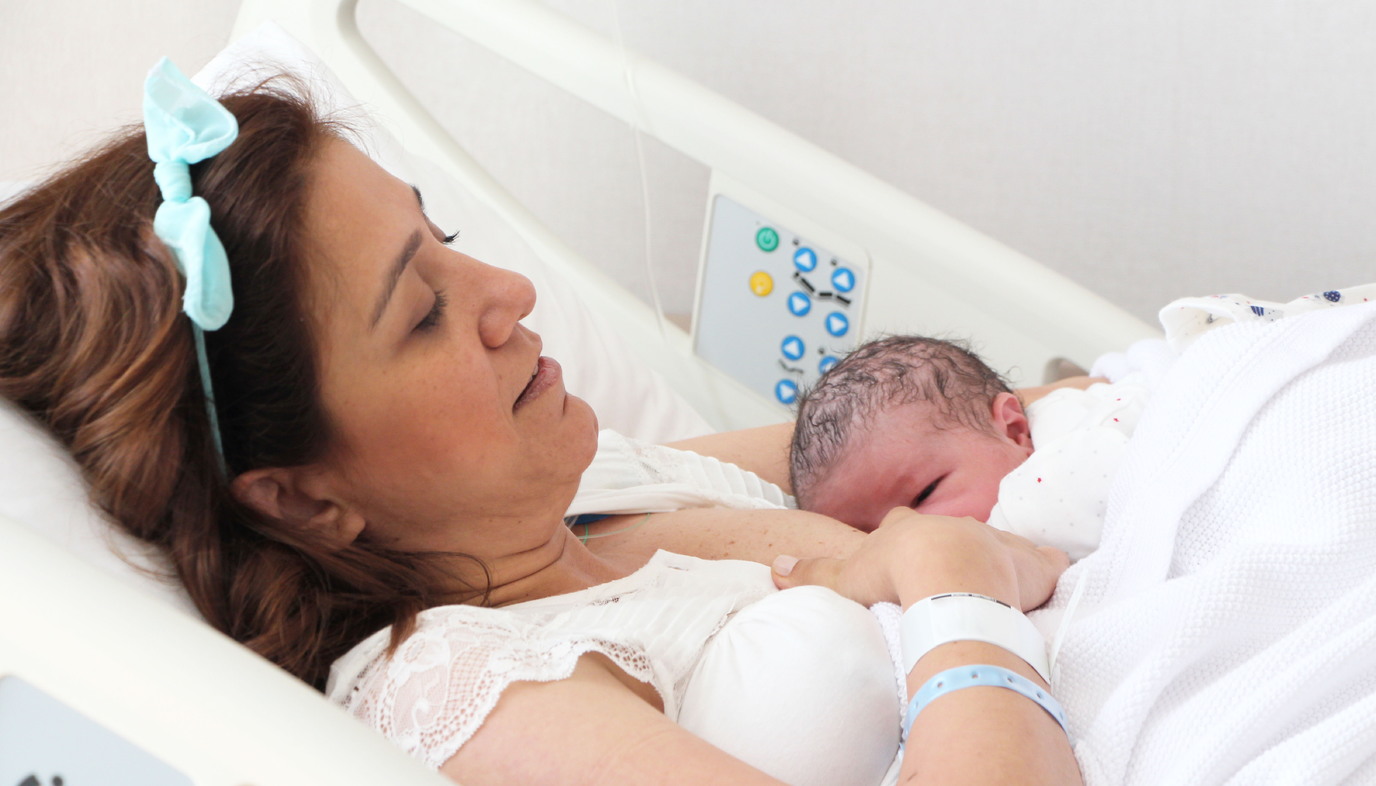
Well you may have hoped your baby would be in your arms by now. You are thirty-nine weeks pregnant now, and there is not much left to do but wait. Stay on the lookout for signs of labor such as a mucous discharge or bloody discharge, cramping or backache, contractions, or your water breaking. Since we have already discussed most of the labor and pregnancy questions, we are going to discuss your new baby in this week’s newsletter. We are going to tell you a little more about what happens in the hospital after your baby is born.
What Is Going on with Mom & Baby

Baby is the size of a watermelon!
Baby: Baby’s crown to rump length is around 37-38 cm (14.6-15 inches). Your baby weighs about 3400-3450 grams (7.5-7.6 pounds). Your baby will be born any day now. All of your baby’s organs are fully developed now. Your baby will continue to put on fat until he is born.
Mom: At this point in your pregnancy, you are probably very uncomfortable. Over the next week, your cervix should start to thin out, if it hasn’t already. You may notice more and more vaginal discharge as you get closer to delivering your baby. Watch your body for signs of labor, and contact your doctor if you start having contractions that are five minutes apart.
This Week’s Pregnancy Checklist
- Double-check your hospital bag and make sure your partner knows where it is.
- Purchase some stationary to write your birth story on.
- If you are still undecided on a baby name, go over your list of choices again.
- Purchase stamps and/or envelopes to mail your birth announcements.
- Go see a movie, walk on the beach, or other fun date for you and your partner.
- Take a new belly picture for your scrapbook or journal.
What to Expect After Baby is Born
Here are some things you can expect to happen after you give birth.
Vaginal and Episiotomy Care:
If you have given birth vaginally expect to have some soreness, especially if you have had tearing or an episiotomy. Your nurse will give you a large menstrual pad and a pair of mesh underwear to wear for some time after you have given birth.
Comfort and pain relief: An icepack will be placed inside the underwear for comfort and to help with swelling. If you are having a lot of pain after birth, ask your doctor what medications you can have for pain. If you have had a severe tear, you may need to take something prescription-strength to help relieve the pain. Don’t be afraid to ask. About 24 hours after you have given birth, you can start taking what is called a sitz bath. You will be given a little plastic tub that you can place under the rim of the toilet. Fill this tub with warm water and let your bottom soak for twenty minutes. You can take this tub home with you and continue taking sitz baths until your vaginal area heals.
Hygiene and signs of infection or postpartum hemorrhage: After birth you will also be given what is called a “peri bottle.” A peri bottle is a little squirt bottle that you fill with warm water and squirt on your perineum. You should use the peri bottle every time you use the bathroom to help keep the area clean and also for comfort. After you give birth you can expect to have bleeding. This may be similar to a period or may be heavier than a normal period for you. You may pass small clots and lochia (a mucousy discharge that is seen after birth). Small clots are normal but if you notice large clots that are golf ball size or bigger this can mean that you are having a postpartum hemorrhage which is an emergency situation. If you experience heavy bleeding (soaking through a pad or more an hour) or are passing large clots, contact your doctor immediately. Other things to look for after birth are fever, redness or swelling in the vaginal area, foul smelling discharge, or abdominal pain.
C-Section Care:
If you have had a cesarean, you will also be given a pad and mesh underwear. Your bleeding will be similar to a woman who has given birth vaginally. Your nurse will monitor your bleeding and assess your flow. After having a c-section, as with any surgery, you are at risk of developing infections such as pneumonia. You will be given instructions on coughing and breathing exercises to do to keep your lungs clear and prevent infection. Within the first 24 hours, your nurse will want you to get out of bed and will encourage you to use the bathroom. Since you will have had a catheter in place, you may not feel the need to urinate right away or urinating may be painful at first. Walking around is important for your recovery. It will be painful to move around at first. Your nurse will show you how to use a pillow for support by pressing it against your incision as you move around or try to get out of bed. You may also want to keep a small pillow handy for your ride home from the hospital. It will help make moving around more comfortable during your first days home.
Caring for your incision and signs of infection: You will be given instructions by your nurse on how to care for your incision. Your incision may be covered with adhesive strips. These generally fall off on their own within a week. You should clean your incision daily with soap and water and watch for signs of infection. If you notice redness, swelling, puss or drainage around your incision, or if you have a fever you should contact your doctor right away as these are signs of infection.

Caring for Your New Baby
Here Are Some Baby Care Basics:
Diaper care: While you are the hospital, you will be provided with disposable diapers. Try to check your baby’s diaper every hour or two, especially if he is fussy. Your baby will be passing meconium at first, a black or greenish-black tar-like substance. Your baby will have meconium stools that gradually change over to more normal looking stools over a day or two. If your baby is breastfed, you can expect him to have frequent bowel movements that look seedy, runny and mustard colored, often every time you feed him. If he is formula-fed, he will also have frequent bowel movements in the beginning, but they will be more of a tan color and have a thicker peanut butter consistency. When you change your baby’s diaper you will want to fold the top of the diaper over so that his umbilical cord stump is not covered. Once his umbilical cord stump falls off, you can stop folding down his diaper.
Bathing: Until your baby’s umbilical cord falls off and heals, you should only give your baby a sponge bath. Use a warm wet washcloth and a gentle soap designed for baby's sensitive skin to wash your baby.
Feeding: If you are breastfeeding your baby, try to feed your baby within the first hour of birth. This will help with your milk production, and the colostrum is very beneficial to your baby. Breastfeed you baby frequently, every two to three hours at first. Nursing your baby frequently will help improve your milk supply. If you are formula feeding, prepare a small two or three ounce bottle of formula for your baby. Your baby will need to be fed about every three to four hours. If your baby doesn’t finish the entire bottle, the remaining formula needs to be tossed out. Watch your baby’s cues. If he finishes off his bottles regularly and still acts hungry, you can gradually increase the amount of formula you give him. You do not really have to warm up the baby’s bottle; however, some babies prefer warm bottles over cold. If you do warm the baby’s bottle, do not use the microwave. Microwaving heats the formula unevenly, creating hot spots that can burn your baby’s mouth. When warming formula, fill a small container with hot tap water (do not boil) and soak the bottle in the water until it is warm.
Comforting: Trying to interpret your baby’s cries can be tricky at first. When your baby cries, you should check for immediate discomforts first. Is his diaper wet or dirty? Sometimes babies cry when they are having a bowel movement. Your baby is just getting used to how his body works and he may cry, grunt or turn purple when making a bowel movement. If he is still crying after checking his diaper, see if he is hungry. Babies usually alert you with hunger cues such as sucking on their fingers, fidgeting, or trying to suck on whoever is carrying baby. Another reason baby may be crying is because he or she needs to burp. Try to rub or pat your baby’s back until he burps after each feeding. If baby is still crying and he doesn’t have any physical needs, he may just need to be swaddled, shushed, or rocked. It may take you some time to figure out what comforts your baby, but in time you will discover what makes your baby feel better.
Next Week: 40 Weeks Pregnant: Your Pregnancy Week by Week
Previous Week: 38 Weeks Pregnant: Your Pregnancy Week by Week
